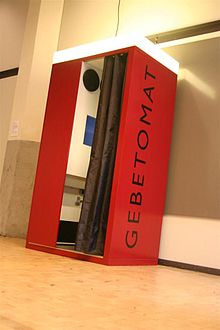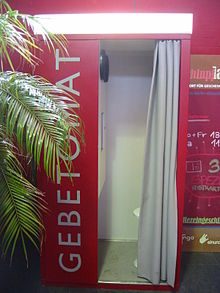Prayer machine
The Gebetomat is a cabin-shaped media installation by the artist Oliver Sturm from 2008 for audio playback of prayers .
function
The machine offers the user the opportunity to contemplate: by listening to prayers, as a retreat for one's own prayer or by using the cabin as an acoustic space. The constantly expanding audio archive contains prayers from the five world religions - Buddhism , Christianity , Hinduism , Islam and Judaism - as well as numerous smaller religions and beliefs. The current approximately 300 prayers in 65 languages are authentic prayers of believers, collected in church services, prayer rooms, apartments and places of all kinds. The prayers of the world religions are structured according to their beliefs, those of the other religions according to their ethnic or geographical background.
Oliver Sturm: "I consider the idea - which is related to Andy Warhol's thinking - of an automatic production of religious feeling to be a very contemporary idea."
production
The prayer machine was produced in cooperation with "ausland and Sophiensæle Berlin", the ARD radio play days, the Karlsruhe Center for Art and Media Technology and the Künstlerhaus Mousonturm.
The prayer machine is intended for train stations, subway stations, empty churches, prayer rooms in universities, airports, department stores, urban squares, motorway rest stops and other places of public life. In 2013 there were four Gebetomat cabins; In 2016 there are currently six.
Previous locations (selection)
- Sophiensaele , Berlin (for the festival "Your Word in God's Ear")
- Center for Art and Media Technology , Karlsruhe
- Künstlerhaus Mousonturm , Frankfurt am Main
- OpenOhr Festival , Mainz
- House of World Cultures , Berlin
- Radialsystem V , Berlin
- Hessischer Rundfunk , Frankfurt am Main
- Museum Villa Rot, Burgrieden
- art Karlsruhe, Karlsruhe
- Kulturbrauerei , Berlin
- Südwestrundfunk , Baden-Baden
- Moabiter Markthalle , Berlin
- Philipps University of Marburg , Department Ev. theology
- Catholic University of North Rhine-Westphalia Cologne
- Edeka shopping center Baur, Constance
- Thomas Esser Vocational College, Euskirchen
- Mariengymnasium Arnsberg
- Stuttgart Airport , Terminal 3 airside
Web links
- Gebetomat website
- Deutschlandradio Kultur: Religion to go
- The Berlin literary criticism: sound experiments and “Gebetomat” at ARD radio play days in Karlsruhe
- Vatican Radio: D: Prayers from the machine ( Memento from March 24, 2012 in the Internet Archive )
- Report on Nikkei BP (Japanese)
- Report on News RU (Russian)
- Report on religio.ru (Russian)
Individual evidence
- ^ Peter Neumann: Praying in the automat. In: Berliner Zeitung . November 8, 2008, accessed May 7, 2010 .
- ↑ locations. Retrieved October 9, 2013 .
- ↑ Divine service “Many Religions - One Room”. Retrieved October 9, 2013 .

